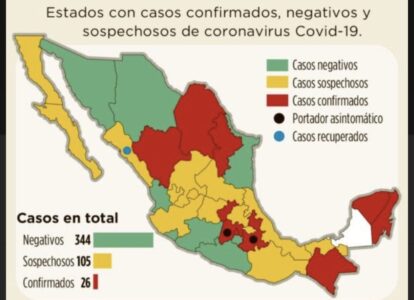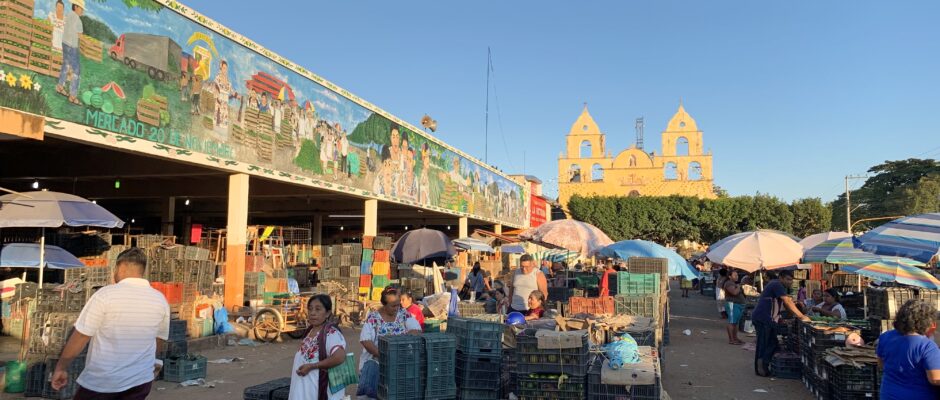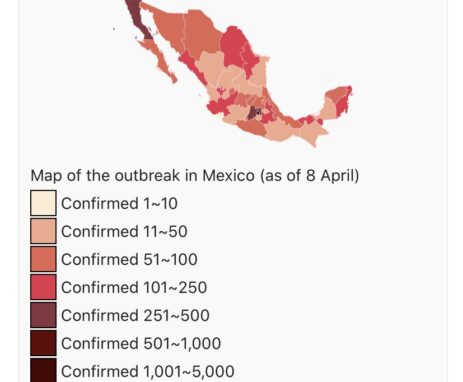
Mexico in the time of COVID-19
If you are like many that have an interest in Mexico, you have been following the spread of the corona virus (covid-19) around the world. As we see the spread, some wonder about factors that limit it and how will places fare. Will warm weather locations slow the spread? Are there genetic factors that come into play? What type of restrictions works the best? We might not know the answers to these questions for some time. Maybe not until the disease is under control and we can analyze all the data will we have conclusive answers. What we do know is the general pattern of how this disease spreads. It starts off with small numbers and then once there is community spread, it takes off. As of the first half of April 2020 Mexico has had a relatively few deaths compared to other countries. If covid-19 take a foothold in Mexico, we could see a widespread epidemic in the country because of cultural and economic factors. We will examine these in this article.
The examples that have come before Mexico
So far we have about three sets of examples of covid-19 spreading and how it progresses. We have China, Europe and the United States as examples. Italy was one of the first western countries that had a large outbreak. It surprised many as it quickly grew out of control, leading the north of Italy and then the entire country being on lockdown. Over and over, we have seen small numbers at the beginning and then once community spread happens, it begins to double every few days. This spread also raises the risk of more fatalities.
What we have seen in most countries battling this corona virus are some of the same moves. Social distancing, closures, restrictions on how people shop, and quarantining in the homes. So far, many of the countries that have dealt with covid-19 are more of the wealthier countries and ones that are structured differently than Mexico. There are cultural, structural and economic differences that make Mexico more prone to higher rates of infection. Let’s examine some of these factors.
How Mexicans Shop
Recent recommendations from health authorities have been for people to shop as little as possible and buy what they need for the week at one time. Mexicans, however, are used to buying daily, at least some basics if not a majority of food stuffs for the household. One of the most basic things that is eaten in Mexico are tortillas. These are made daily at tortillerias. Each neighborhood has one and buying fresh tortillas is just one example of how Mexicans shop daily and differ from other countries. A second factor is the lack of refrigeration in rural area. In many small towns around Mexico people do not have refrigerators. This means that the corner store is the local refrigerator. If it is a cold drink or a cold cut, it warrants a trip to the local store.
These simple factors mean people in Mexico traditionally are out shopping more, bringing them into contact more than some other countries.

Economic Factors
There have been preliminary studies that show how disproportionate COVID-19 effects those of certain social economic groups. When many countries went into quarantine mode, people resorted to working online when possible. In Mexico there is a drastic number of jobs that cannot be performed online. This means that either people need to continue working in public or cannot work at all.
Many people in Mexico work and use their payments to pay for expenses on a daily or weekly basis with not much savings. This means that there is an increased need for people to keep working. In places around Mexico that have not instituted a strict stay at home order, many people still are still working. Even when nonessential businesses are asked to close, there is the large informal economy that continues to run. This includes day laborers, construction workers, and other gig economy jobs. Because of the need for working to pay for basic expenses, this means more people are not at home in quarantine and exposure to spreading the corona virus in Mexico is higher.
Living conditions in Mexico
The average household size in the United States is 2.52 people. In Mexico the average household size is 3.8 people. That might not seem like a big difference, but this means the average household in Mexico is about 33% larger. This means that more people are living together under one roof. Combine this with the proximity of how close many people live to one another in communities, this means much closer interaction between people that can lead to further spread of COVID-19.
Health Factors and the Spread of the Corona Virus in Mexico
As we have seen in other countries now being affected by COVID-19, many of the fatalities are with people with pre-existing conditions. Some of these are diabetes, hypertension and obesity. Mexico has a poor record for many of these conditions. Obesity in Mexico, for example is found in about 30% of adults. This puts Mexicans at a higher risk for health complications that some other countries.
Hospitals in Mexico
Hospitals in Mexico are not as well equipped as other North American or European countries. For example, the hospital bed ratio per 1000 people in Mexico is 1.38 compared to Canada with 2.52 beds per 1000 and the United States at 2.77 beds per 1000 persons. Of course, having beds is one thing, but having sufficient equipment is another thing. Most hospitals in Mexico lack the latest technology and enough machines for the size of the hospitals.
We personally have been in some local hospitals and have seen (and experienced) equipment that is about 10 years old that does not function as well as it should, rusty hospital beds, and even bathrooms with no soap or paper towels. This is just some anecdotal evidence showing the state of some hospitals in Mexico. In larger cities there are modern facilities that function very well, but as is the case with each country in the world, this pandemic is overwhelming the system. With under equipped medical facilities in Mexico, it will be an uphill battle if the caseload rises due to COVID-19.
Sanitation in Mexico
In most parts of Mexico there is a different type of sanitation system for toilet wastepaper. It is common to see a wastepaper basket next to the toilet in Mexico. This means that wastepaper and fecal matter are in trash cans, and it is later emptied. COVID-19 has been detected in fecal matter, according to the CDC, however at this time there are many unknowns regarding transmission in this regard. It is however something to consider since this is a different situation than other countries and presents possible risks.
Is the COVID-19 virus found in feces?
The virus that causes COVID-19 has been detected in the feces of some patients diagnosed with COVID-19. The amount of virus released from the body (shed) in stool, how long the virus is shed, and whether the virus in stool is infectious are not known.
The risk of transmission of the virus that causes COVID-19 from the feces of an infected person is also unknown. However, the risk is expected to be low based on data from previous outbreaks of related coronaviruses, such as severe acute respiratory syndrome (SARS) and Middle East respiratory syndrome (MERS). There has been no confirmed fecal-oral transmission of COVID-19 to date.
So, is it all bad news?
The fact that some of the early expectations for peak infection in Mexico have not materialized, or at least not yet arrived, is a possible good sign. Some of the other good factors going for Mexico is the age of the population. Mexico has a median age of about 26.8 years old and about 85% of the population is under age 55. The virus has less impact on younger populations that are healthy.
Mexico is in general, less connected both internally and globally. The places in Mexico currently with higher rates of infection are tourist destinations and the capital of Mexico City. This shows how the spread has been impacted by the connection between these parts and the rest of the world. Many towns are semi-independent and are more sustainable communities with less interaction with others population centers. This could help slow the spread of COVID-19. Even more restrictive, some municipalities in Mexico have closed their entrances to residents only in an effort to protect their residents. This has stopped people from casually spreading the corona virus in Mexico and highlighted to residents to take it seriously.

At this time, those in Mexico can take heed of the recommendations of quarantining and cleanliness as close as possible. COVID-19 is a dangerous disease and there are different risk factors in Mexico that make it more prone to spread. We all can hope for the best and prepare for the worst as now it is Mexico’s turn to face the spread of COVID-19.
To see updates on the spread of the corona virus in Mexico and get current health advisories, here are two links for you:
- The John Hopkins Corona Virus Map
- The Mexican Department of Health (in Spanish)
- The Quintana Roo Heath Department updates for the Riviera Maya and Playa Del Carmen area (in Spanish). At this link you can find the charts like below.



I see you were pretty accurate in your article since this was written about a month ago and the cases have been rising each month in Mexico. In fact one of the countries will exponential growth.